1.
Robert Dunne was born probably in the summer of 1835 in Drogheda or
Dublin, Ireland, but no record of his birth has yet been traced. The dates on his gravestone
only serve to confuse matters further, recording that.....
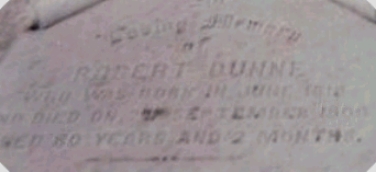
...."ROBERT DUNNE
(WHO) WAS BORN IN JUNE 1810
AND
DIED ON 2ND SEPTEMBER 1900
AGED 80 YEARS AND 2 MONTHS".
(Records indicate that his mother was born about (?)1812)....
Details of his early life therefore remain
obscure as do those relating to his natural father, but Public Records Office documents (WO 25/3240)
attest that his mother, Mary Jane Dunne married George William Rafferty in
St.Peter's Church, Dublin on 10th October 1848. Her age is given as 36 years. By then Robert was probably in
his early teens. Letters in later years show that Robert and his step-father enjoyed a
close and amiable relationship. Nevertheless this did not prevent George Rafferty
from admonishing Robert when he deemed necessary for lack of ambition, failure to reply to
family correspondence and, ultimately what Rafferty saw as a clear sign of his step-son's lunacy, the decision to resign from the army. (See
Rafferty's letters of 13/2/1860,
30/5/1860,
26/6/1860, and
27/8/1860).
Unfortunately none of Robert's replies to these reprimands survived, but we may
imagine that with the hardships of the Crimea still fresh in his memory, he
probably remained quite impassive and unperturbed by his
stepfather's jibes.
2.
The first known mention of Robert Dunne in official records (PRO doc.WO 23/45)
is when he enlists in the British Army on 15th June 1853 at Liverpool, shortly
before his 18th birthday.The following day he travelled to Chatham to join
the 99th (Lanarkshire) Regiment, recently returned from duty in Tasmania.
His name appears in the June regimental muster roll and alongside is noted "PAID
16-30 June".The next mention of Dunne of any note is in the October and November 1853 Muster Rolls where his absence from muster is annotated as
"Hospital". It is not clear whether he was actually sick in
the garrison hospital, or whether he was serving as a "Hospital
Orderly", though this latter phrase has been entered alongside other
names. Similarly, in the December Muster Roll, reason for his absence is given as
"Guard". Was he on Barrack Guard duty or under guard? As there
were no deductions from pay during these periods it seems reasonable to assume
that he had not been ill nor misbehaved, but was merely carrying out general
barrack duties.
3.
During February 1854 Robert and ten other Privates from the 99th (including
Thomas Grady, subsequently awarded the Victoria Cross for valour at Sebastopol
Harbour),volunteered
to join the 4th Regiment of Foot (The King's Own Royal Regiment - see history of King's Own Royal Regiment). 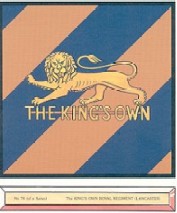 Men from at
least twenty other Infantry regiments, also keen to see action, made the same
decision. Robert Dunne first appears on the Pay List for the 1st Battalion of
the 4th Regiment of Foot in March 1854, by which time the Regiment had been
garrisoned at Edinburgh Castle for almost a year. The 4th was one of several
regiments recently told to prepare themselves for departure "for the
East", and this fact had quickly spread throughout the British
Army, prompting many young men in search of adventure to request a transfer to one of these
Regiments. Three weeks after Robert and the others arrived in Edinburgh their new
Regiment mustered with full kit ready to sail.
Men from at
least twenty other Infantry regiments, also keen to see action, made the same
decision. Robert Dunne first appears on the Pay List for the 1st Battalion of
the 4th Regiment of Foot in March 1854, by which time the Regiment had been
garrisoned at Edinburgh Castle for almost a year. The 4th was one of several
regiments recently told to prepare themselves for departure "for the
East", and this fact had quickly spread throughout the British
Army, prompting many young men in search of adventure to request a transfer to one of these
Regiments. Three weeks after Robert and the others arrived in Edinburgh their new
Regiment mustered with full kit ready to sail.
Departure "for the East"
(adapted from an original article by George Robinson).

...."ROBERT DUNNE
(WHO) WAS BORN IN JUNE 1810
AND DIED ON 2ND SEPTEMBER 1900
AGED 80 YEARS AND 2 MONTHS".
(Records indicate that his mother was born about (?)1812)....
2.
The first known mention of Robert Dunne in official records (PRO doc.WO 23/45) is when he enlists in the British Army on 15th June 1853 at Liverpool, shortly before his 18th birthday.The following day he travelled to Chatham to join the 99th (Lanarkshire) Regiment, recently returned from duty in Tasmania. His name appears in the June regimental muster roll and alongside is noted "PAID 16-30 June".The next mention of Dunne of any note is in the October and November 1853 Muster Rolls where his absence from muster is annotated as "Hospital". It is not clear whether he was actually sick in the garrison hospital, or whether he was serving as a "Hospital Orderly", though this latter phrase has been entered alongside other names. Similarly, in the December Muster Roll, reason for his absence is given as "Guard". Was he on Barrack Guard duty or under guard? As there were no deductions from pay during these periods it seems reasonable to assume that he had not been ill nor misbehaved, but was merely carrying out general barrack duties.
3.
During February 1854 Robert and ten other Privates from the 99th (including Thomas Grady, subsequently awarded the Victoria Cross for valour at Sebastopol Harbour),volunteered to join the 4th Regiment of Foot (The King's Own Royal Regiment - see history of King's Own Royal Regiment).
 Men from at
least twenty other Infantry regiments, also keen to see action, made the same
decision. Robert Dunne first appears on the Pay List for the 1st Battalion of
the 4th Regiment of Foot in March 1854, by which time the Regiment had been
garrisoned at Edinburgh Castle for almost a year. The 4th was one of several
regiments recently told to prepare themselves for departure "for the
East", and this fact had quickly spread throughout the British
Army, prompting many young men in search of adventure to request a transfer to one of these
Regiments. Three weeks after Robert and the others arrived in Edinburgh their new
Regiment mustered with full kit ready to sail.
Men from at
least twenty other Infantry regiments, also keen to see action, made the same
decision. Robert Dunne first appears on the Pay List for the 1st Battalion of
the 4th Regiment of Foot in March 1854, by which time the Regiment had been
garrisoned at Edinburgh Castle for almost a year. The 4th was one of several
regiments recently told to prepare themselves for departure "for the
East", and this fact had quickly spread throughout the British
Army, prompting many young men in search of adventure to request a transfer to one of these
Regiments. Three weeks after Robert and the others arrived in Edinburgh their new
Regiment mustered with full kit ready to sail.
4.
On 8th March 1854, a windy overcast day, No.3320 Private Robert Dunne lined up
with over 900 Regimental comrades on the Esplanade at Edinburgh Castle, awaiting
the order to march the 3 miles through Edinburgh (see route)
to Granton Docks and the ship which would take them on their first step towards
war with Russia. Shortly before one o'clock, silence descended over the ancient
fortress and Brevet Lt.Col. Sadlier (the commanding officer in Colonel Sir J.Bell's
absence) gave the order for the eight Companies to march off through
the streets. In perfect formation, the Regiment shouldered their muskets, while
the men of the 82nd (Prince of Wales' Volunteers) who had arrived in Edinburgh that morning to take over
the 4th's garrison duties crowded the battlements to give three cheers to the departing
troops. The mounted band of the 7th Hussars led the way as the column wound
their way down the cobbled Castle Hill, cheered on by the waiting crowds. Each
man, resplendent in red jacket, carried a black leather ammunition pouch, a
knapsack, mess tin and a folded overcoat worn at the rear. A white canvas
haversack and wooden canteen completed his heavy and cumbersome equipment.
Although the Regiment had been issued with 250 rifles of the new Minie design,
the majority of the men carried the old-style smooth bore musket. Their progress
began to slow around Bank Street, the narrower stretch of their route, and
wives, friends and girlfriends kept pace with them. Windows of tenement blocks
were packed with cheering spectators and flags were being waved from akmost every building.
Down the steep cobbled incline of The Mound towards Princes Street thousands
more were waiting to cheer them on their way. The crowds continued to follow
them as they marched into Hanover Street and down the slope to Canonmill Bridge.
Still more well-wishers thronged to greet them as they made their way along
Inverleith Row and out towards Granton Harbour.
5.
By early afternoon the column had arrived at the dock area. Again more crowds
awaited them and some daring souls had even climbed onto warehouse cranes and roofs to
catch a glimpse of the departing troops. Two tug boats and a steamer -"The
Maid of Leven"- were waiting to take the men out to the 2,500 ton freight
ship, "Golden Fleece", and by 2.00 p.m. the first detachment was
leaving the dockside for the ship. By 5.00 p.m. all personnel (32 officers, 911
NCOs and privates and 26 wives) were safely aboard,
together with two officers' horses. Throughout the afternoon several vessels had
been ferrying cheering sightseers and relatives around the ship to wave to the
redcoated infantrymen lining the decks, but eventually the swell made the
journey too rough for many of the smaller craft.
6.
Unfortunately the loading of additional stores delayed the ship until the
following day. The Regiment's departure was therefore a low-key affair and in
stark contrast to the jubilant atmosphere of the the previous day; there were no
bands, no flags or fluttering handkerchiefs and no tears. Only the "Golden
Fleece", firing her guns in salute signalled their departure as she finally
headed down the Firth of Forth towards the open sea for Malta. Of the 943 men of
the 4th Regiment who had proudly marched through Edinburgh the previous day,
over a third would not survive the terrible conditions encountered in the
Crimea; yet enemy action accounted for just 35 of those lives lost.
7.
On 25th March "The Golden Fleece" reached Malta; three days later
France and Britain declared war on Russia. On arrival in Malta the 4th were ordered to
encamp behind Fort Manoel, together with many other regiments preparing for possible departure to the Crimea.
Malta-Varna
8.On 10th April they embarked on the freight ship the Emeu, having already lost one of their number, drowned whilst swimming in Malta. A further 5 had fallen sick and had to remain behind. Within 6 days they had reached Constantinople, and after a short stay sailed on to the Black Sea port of Varna. At this stage the regiments were still unaware of their final destination in the Crimea, or whether they would even be called upon to fight at all. It was only after a further three months, and shortly before they sailed on HMS Terrible from Varna to Balschik Bay on 31 August, that Sebastopol was finally confirmed as their destination.
Varna to Sebastopol
9.
The combined Allied fleet now totalled about 500 vessels, of British, French and Turkish origin. Sailors who had initially looked on as the British troops embarked noted during the voyage that what had previously been a thin and unhealthy-looking body of men was slowly improving in health and general appearance. Indeed they were generally in better health now than at any time in the previous three months. This was largely attributed to the improved rations, clean (sea) air and less cramped conditions which they enjoyed on board ship compared to those in camp at Varna. Deaths from Cholera among the infantry, for example, were reduced to just 72 during the voyage. The French on the other hand, who on one ship alone had crammed 2400 men, not surprisingly fared less well, and landed ashore some 1100 men fewer than had embarked at Varna.
10.
This enormous armada reached Calamita Bay, just 35 miles from Sebastopol on 14th September, anchoring about 3 a.m. Although the landing of men and supplies took about five days, surprisingly they were unopposed. The Monthly Return for the 4th Regiment for this period states that they landed at Lake Tongla (or Tangla), though no mention of this lake has yet been found in any other account of the landing. There is, however, a village and lake named Tuzla some 3-4 miles North-East of Kamishlu lake, where some British troops, particularly those from the 4th Division, eventually came ashore. It may be this lake which they erroneously named Lake Tongla, or Tangla. Perhaps this gives some credence to the suggestion that the 4th Foot were part of the 4th Division, as some sources maintain.
11.
Most historians however, would agree that the 4th Regiment, together with the 28th and 44th Foot Regiments and F and W Batteries of the Royal Artillery formed the 2nd Brigade under the command of Brigadier-General Sir William Eyre, and, with the 1st Brigade, commanded by General Sir Colin Campbell, made up the 3rd Division led by Lt.General Sir Richard England. Some sources give conflicting details on the formation of these Brigades and Divisions, and, as mentioned above, even place the 4th Regiment in the 4th Division. However the front cover of a Muster Roll book at the PRO dated 31 April 1856 is entitled "1st Brigade, 3rd Division, 4,14,39,50 and 89 Regiments"..! (PRO doc.WO 14-18).
Alma
12.
On 19th September the troops set out on their march to Sebastopol. By the 25th they had reached the River Alma, where they were engaged by Russian troops under Prince Menshikov, commanding 33,000 infantry and 3,400 Cavalry, and supported by 28 guns.
13.
The Battle at the Alma raged fiercely yet lasted little more than ninety minutes; in this short time, Russian casualties had reached a staggering 5,000. The British and her allies had lost 352 killed and 1600 wounded. It was the first British military victory for almost 40 years, and morale was high. The British success can be attributed largely to the use of the new Minie rifle, many of which had been issued shortly before the troops' departure from Britain. However the 4th Regiment still had only 250 rifles for over 800 troops who sailed from Malta. The remainder still carried "musquets". Although the Minie was still a muzzle-loading weapon like the old smooth-bore musket it replaced, it used a rifled barrel and a bullet, rather than a musket ball. Its range and accuracy were markedly superior; it is generally accepted that a ratio of 1 in 16 rounds from a Minie were accurate, compared to 1 in 460 of the old weapon. Furthermore the Minie benefited from a much increased range of approximately 800 yards.
14.
The role of the 4th Foot Regiment at Alma is unclear, and there are again discrepancies in the various accounts. One source states that only six companies of the Regiment saw action at Alma, while at least two other sources omit it from the Order of Battle completely.
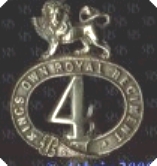
15.
Following the battle, the Allies continued their march towards Sebastopol. By this stage many troops, particularly those of the 4th Foot, succumbed to general fatigue and further outbreaks of cholera. Somewhat depleted therefore, they arrived in front of Sebastopol on 28th September and set up camp. Thus began the Siege of Sebastopol, which was to last until the following September. It was to impose on those involved some of the most rigorous conditions ever endured by British troops.
Sebastopol
16.
On the 17th October the Allies started their artillery barrage on Sebastopol which severely damaged the town's defences, yet did not break the resistance or morale of those within. Sebastopol held on. Had it not done so, many Allied lives might have been saved, but the main objective, that of toppling Russia from her position as a strong European power, might not have been achieved. As it was, Russia did not again rise to such prominence until 1945. At Sebastopol, the barrage continued for several days, and Prince Menshikov finally brought out a force from the town consisting of some eighteen battalions of Infantry and Cossack Cavalry; the attack was eventually repulsed, due mainly to a courageous counter-attack on the Cavalry by the 93rd Highlanders commanded by Sir Colin Campbell - "The thin red streak tipped with steel" - wrote William Russell, Irish war correspondent of The Times newspaper who was present, though his description was misquoted forever afterwards as "The thin red line".
Inkerman
17.
On 5th November the Allies again saw action at the Battle of Inkerman. The bulk of the 3rd Division, however, presumably including Robert Dunne and the 4th Regiment, appear to have remained in the siege lines around Sebastopol and were not involved. Due more to the courage of the ordinary troops and less to the qualities of leadership demonstrated by their Commanders, the Allies finally triumphed. It was a hard fought, brutal battle, with small pockets of troops separated from their comrades and Commanders by thick swirling fog, focusing on advancing Russians only at the last moment, by which time they were forced to engage in fierce hand to hand fighting. 2,500 British soldiers and 12,000 Russians lost their lives.
18.
As the winter of 1854 set in, the British euphoria brought on by the Allied victories at Alma and Inkerman was soon to evaporate. It was bitterly cold, supplies of food, warm clothing and tents were either insufficient or non-existent, and cholera persisted unabated. The duty of digging trenches, hard enough work at the best of times became almost impossible for men who had had little to eat and little warmth in their bodies. They slept on wet blankets on wet earth, and their clothes were sodden for much of the time. The trenches soon filled with mud, so that a period of picket duty consisted of cowering down for several hours at a time out of sight of Russian snipers. There was very little water for them to wash off the mud subsequently, and they became dirty, unkempt and lice-ridden. Virtually no wood existed for fires, and more often than not meals were eaten cold. Not surprisingly British morale was at a very low ebb, particularly when they compared their lot to that of the well-supplied French, whose warm camp fires they could see burning in the distance.
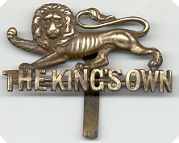
19.
The 4th finally returned from the Crimea in July 1856; Queen Victoria herself reviewed several Regiments at Aldershot on 8 July, accompanied by her uncle, King Leopold of Belgium. British troops were awarded the Crimea Medal, which Her Majesty had instigated in November 1854 for presentation to troops who had taken part in the siege of Sebastopol. Clasps were also awarded for involvement at any of the other three major land engagements (Alma, Inkerman, Balaclava). A clasp was also awarded to sailors who saw action in the Sea of Azov engagement, and to the handful of soldiers on board the vessels involved. The Turkish Crimea Medal was awarded by the Sultan of Turkey at the end of the campaign as a token of gratitude for the Allies' help. The obverse of the medal depicts a field gun on which is spread a map of the Crimea. In the background are the flags of Britain, France, Sardinia and Turkey, with the words "Crimea 1855" in English, French or Italian. The flag of the recipient's nation was positioned to the fore alongside the Turkish flag. The reverse shows the Sultan's cypher within a laurel wreath and the word "Crimea" in Turkish and the date in Arabic. Unfortunately the ship bringing back the British medals was wrecked and British troops eventually received medals minted for either France,Sardinia or Italy. Although some Regiments arranged for the medals to be engraved with the recipient's details before presentation, others expected their troops to arrange the engraving themselves later. Robert Dunne was awarded both the Turkish and the British medal, with three clasps for Alma, Inkerman and Sebastopol.
And so to India......
20.
On his return from the Crimea, Dunne was stationed with his Regiment at Aldershot for two months, and then, no doubt very much to his liking, Dublin. However by July 1857 the Regiment were ordered to embark for Mauritius. After just three months in Mauritius, the need for additional troops to quell the rebellious disturbances that became "The Indian Mutiny" meant the deployment of the Regiment to the sub-continent, and they arrived at Karachi in September 1857. Few details are known of Dunne's service in India at this time, apart from those we can glean from his step-father's letters and the occasional notes alongside his name in the Regimental Muster Rolls, e.g..."To Bombay 9th,"; "From Bombay 21st"; "To Field service 30 inst"; "From Field service 16 inst".
21.
By April 1860 he has obviously grown tired of army life and clearly feels that a more lucrative career awaits him on the rapidly developing Indian Railways.
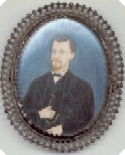 Judging by his step-father's replies Robert has obviously been recommending the
Railways as a sound investment for the future. We can also read from his
step-father's replies the anxiety that both he and Robert's mother feel about
this venture which they consider to be extremely foolhardy. He has been fed,
clothed and accommodated by the Army for more than seven years; he has been in a
secure,if not always safe occupation and earned a steady wage, and his
intention to give up all this for some hare-brained scheme to commence
work amongst the natives is totally
incomprehensible to his parents. Although George Rafferty tries his best to
dissuade Robert,he is not to be deterred. On 6 February 1861 when his Regiment
was again stationed at "Karachee"he purchased his discharge
from the British Army for just eighteen pounds, a substantial sum at the
time. His Commanding Officer Captain
John McDowell Elliot, writing a letter
of reference, commends him as a "steady, sober, good soldier" - not a
phrase used to describe all Privates during the Victorian era! He had served
with the British Army for just 7 years 185 days "over 18" years of age
and was not therefore entitled to a pension. We must calculate that he was approximately 26 years of
age.
Judging by his step-father's replies Robert has obviously been recommending the
Railways as a sound investment for the future. We can also read from his
step-father's replies the anxiety that both he and Robert's mother feel about
this venture which they consider to be extremely foolhardy. He has been fed,
clothed and accommodated by the Army for more than seven years; he has been in a
secure,if not always safe occupation and earned a steady wage, and his
intention to give up all this for some hare-brained scheme to commence
work amongst the natives is totally
incomprehensible to his parents. Although George Rafferty tries his best to
dissuade Robert,he is not to be deterred. On 6 February 1861 when his Regiment
was again stationed at "Karachee"he purchased his discharge
from the British Army for just eighteen pounds, a substantial sum at the
time. His Commanding Officer Captain
John McDowell Elliot, writing a letter
of reference, commends him as a "steady, sober, good soldier" - not a
phrase used to describe all Privates during the Victorian era! He had served
with the British Army for just 7 years 185 days "over 18" years of age
and was not therefore entitled to a pension. We must calculate that he was approximately 26 years of
age.Indian Railways
22.
Now free to pursue his ambition he quickly found employment (in April 1861) with the Great Indian Peninsula Railway. His testimonials indicate that he may have worked with this Railway Company while still in the Army, albeit in a temporary capacity. They also show that as contracted labour, and "not through any fault" of his own he rarely worked more than 12 months on any one job, and often much less. It was a precarious existence.
To Abyssinia
23.
Perhaps the railways did not prove to be the successful venture he had imagined, just as his step-father, who had died in June 1866 had foreseen - or perhaps he still retained a thirst for travel and adventure - or perhaps simply wanted a change; whatever the reason, in 1868 he volunteered for the Bombay Naval Reserve who were being drafted to Abyssinia.Undoubtedly he would have been aware that British troops stationed in India were also preparing to leave for Abyssinia and his decision to volunteer may well have been influenced by the fact that his old Regiment the 4th Foot were one of those Regiments selected to go. The objective of the "Abyssinian Expedition", as it became known, was to liberate the British Consul, Charles Cameron, and several other expatriates abducted by the Monarch, King Theodore. Dunne sailed from Bombay with the Expedition in January 1868. His testimonials for this period describe him as an Assistant Boiler Maker and Blacksmith working aboard HMS Semiramis. In a letter to his aunt dated 17 March 1870, shortly after his mother's death, he refers to the fact that he is due to receive the Abyssinian Medal for his part in the campaign, but no other evidence of his receipt of this Medal has yet been found.
HMS Semiramis
24.
The ship on which he sailed to Abyssinia, HMS Semiramis had been built in Bombay in 1840. She displaced 960 tons, generated 300 HP and was armed with 8 guns. A wooden paddle-steamer, she was also described as a "Coal-Hulk" by Commander Robinson, Indian Navy, when giving Dunne a reference in August 1868 shortly after his return from the Expedition. HMS Semiramis was just one of 75 paddle-steamers, 205 sailing ships and 11 small craft which set out from Bombay and Aden to assist with the transport of men and provisions to Abyssinia. At the time the Expedition was considered a formidable and risky undertaking in terms of logistics and supplies, and it was a credit to its organisers that it was a remarkable success.
Back to Indian Railways
25.
On his return to India in July 1868 he again sought employment on the railways, working as a plate-layer, a diver and later an "Inspector of Way", again on the Great Indian Peninsula Railway, and later with the Sinde, Punjab and Delhi Railway and finally the Bombay-Baroda Railway.
A final adventure in Afghanistan?
26.
There is also a possibility that he was in some way involved in the Second Afghan War in 1879/80, though this has never been verified. A photograph believed to be of him seated (front left) with the "Amir of Kabul and his staff" would confirm that he was certainly in Afghanistan, though it is more likely that if he was there it was to work on the laying of a railway between Afganistan and India. A remark to his cousin Robert Dillon,in the same letter gives no clue other than to confirm that he had been "..out of India.." at this time. Two of his swords still exist which are almost certainly Afghan Pulouars, though of course not necessarily obtained in Afghanistan.
Settling down
27.
By 1882, the Jubbulpore Line on which he was working was being extended further afield to Bengal. Perhaps Robert felt he had already travelled far enough and often enough across the Indian Sub-Continent, or perhaps he felt he could do better in his own business; whatever the reason, he bade farewell to the railways.
28.
In November 1882 he happened to be staying in the small town of Kutnee, Central Province (now Katni, Madhya Pradesh) with the intention of remaining there about six weeks, as he says in his letter of 17 November 1882 "..until after Christmas next to see what I might speculate in." However he very quickly established his own lime works business in Kutnee. Gradually, and no doubt through sheer hard work and determination, his business prospered.
Final days
29.Robert Dunne settled in Katni for the rest of his life, never again returning to his native Ireland, though he wrote that he would have liked to do so. Nevertheless he corresponded with his mother, step-father and aunt in Drogheda until their deaths, and subsequently with a cousin, Robert Dillon in Pittsburgh, Pennsylvania. Physically, he must have been very strong. Family folklore relates that he was able to pick up a "length of railway track" in one hand. He tells his cousin in his letter of 8 June 1897 that he is ".. now full 16 stone at present, quite grey regarding my whiskers but my head of hair keeps its colour a dark brown. I owe my beard turning grey owing to shaving at an early age"(!)
30.
Robert Dunne died of fever and heart failure on Sunday September 2nd 1900, probably aged about 65. He had lived through one of the most interesting periods in British history, and had been involved in some of the Empire's most turbulent, significant and dramatic events. He was a veteran of the Crimea, the Indian Mutiny, the Abyssinian Expedition and had assisted in the growth of the new railway network across the Indian Sub-Continent; finally he had set up and prospered in his own business, and this and his descendants still flourish in Katni and other parts of the world. It was no mean feat for a semi-literate Private who was constantly nagged by his step-father to attend the army's education classes. George Rafferty would have been proud of Robert's achievements. Robert's grandson Thomas, who was "turning out a nice child" in Robert's letter of 8 June 1897 (see letter above), sadly passed away on 31 December 1996 aged 100 years, thus breaking a tangible link to the past and the remarkable life of Robert Dunne.
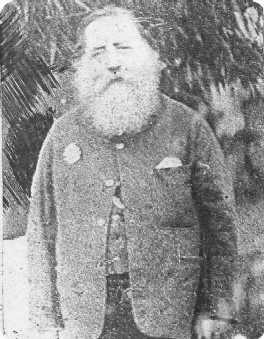
Robert Dunne, c1895
More Photos/Documents Please take a moment to read / sign the Visitors' Book. Thank you. Back to Introduction
Back to top of page©N.S.Chadwick 2002